More Bigfoot “Wallace Line” Images
Posted by: Loren Coleman on February 23rd, 2007
Reexaming archival photographs of Bigfoot track photos, casts, and “souvenirs” does expose hints of how deeply the “cultural icons” of Ray Wallace’s damaging handiwork have penetrated.
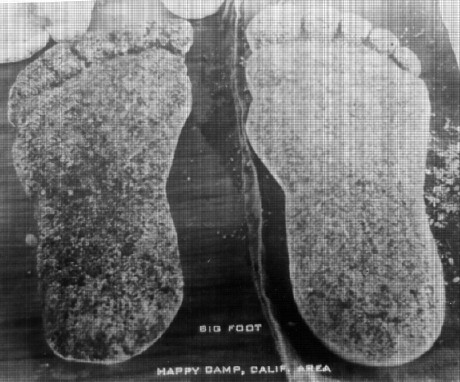
My appreciation is given to Cryptomundo reader Dale Drinnon who has sent in the above scan of an old postcard that was sold at Happy Camp, California, apparently in the 1960s or early 1970s. Drinnon writes: “It looks to me like the one track cast [on the left in the photograph] has [evidence of] that crack in the heel.”
There was nothing on the other side of the postcard.
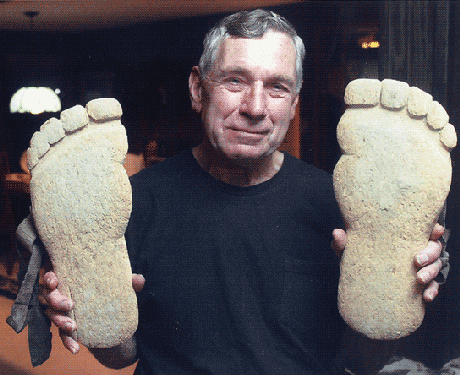
Dale Wallace displays Ray Wallace’s Bigfoot wooden fake feet. (David Rubert Photography – used with permission)
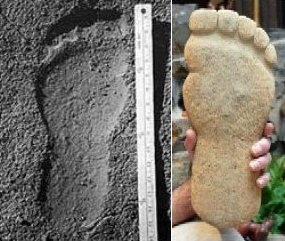
The Wallace wooden fake tools to make Bigfoot tracks; click on the image to make it bigger. (David Rubert Photography – used with permission.)
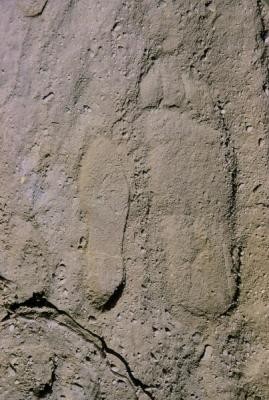
Doreen Hooker’s photographs of the alleged Sasquatch tracks on Blue Creek Mountain – Onion Mountain 1967

René Dahinden photograph, according to Chris Murphy.
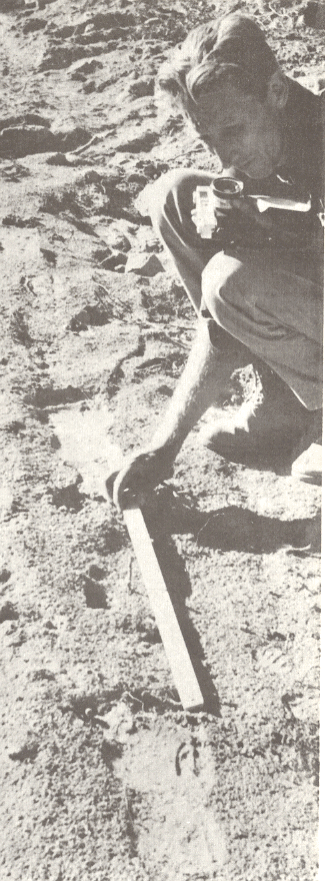

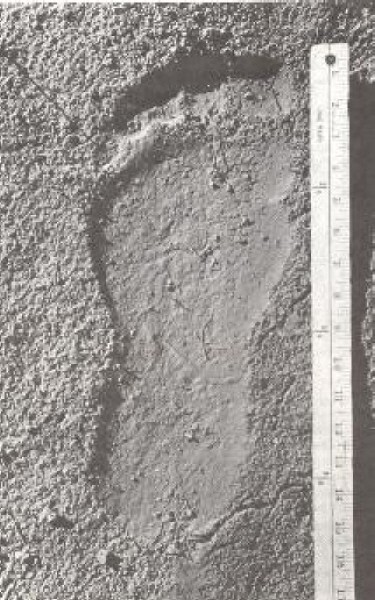
About Loren Coleman
Loren Coleman is one of the world’s leading cryptozoologists, some say “the” leading living cryptozoologist. Certainly, he is acknowledged as the current living American researcher and writer who has most popularized cryptozoology in the late 20th and early 21st centuries.
Starting his fieldwork and investigations in 1960, after traveling and trekking extensively in pursuit of cryptozoological mysteries, Coleman began writing to share his experiences in 1969. An honorary member of Ivan T. Sanderson’s Society for the Investigation of the Unexplained in the 1970s, Coleman has been bestowed with similar honorary memberships of the North Idaho College Cryptozoology Club in 1983, and in subsequent years, that of the British Columbia Scientific Cryptozoology Club, CryptoSafari International, and other international organizations. He was also a Life Member and Benefactor of the International Society of Cryptozoology (now-defunct).
Loren Coleman’s daily blog, as a member of the Cryptomundo Team, served as an ongoing avenue of communication for the ever-growing body of cryptozoo news from 2005 through 2013. He returned as an infrequent contributor beginning Halloween week of 2015.
Coleman is the founder in 2003, and current director of the International Cryptozoology Museum in Portland, Maine.











Well, all I can say is that I’ve never felt that the Wallace wooden feet match the tracks in the photos. I see too many places where lines, angles and arcs don’t match…and neither do the toes. I don’t think shifting dirt can totally account for the mis-matching either.
I’ve also never heard of any convincing evidence that Wallace actually made many fake tracks, other than people’s word for it. Did he cast his own fake tracks or take pictures? If he went to all the trouble, why not?
Also, when reading the early 1958 accounts from the newspapers, he sounded annoyed at losing quality tractor operators. So, I guess the fix was in right from the start and he had some great cover planned…or “real” tracks started him hoaxing?
Just my 2¢
tirademan
I will say it has amused me greatly that people (like for example Ben Radford in his article “Bigfoot at 50”) leap to trust the word of a self-proclaimed hoaxer, being that a hoaxer is, when it comes down to it, a trickster, not to say a liar although I guess you could say that too.
I definitely think that someone with a high stake in Being Believed could start creating hoaxes when people pooh-poohed his genuine experiences.
It seems to me that when someone says they hoaxed tracks everyone believes them.
But those same people don’t believe the people who have seen a bigfoot.
Why do they take the word of the hoaxers but not the others.
Seems funny to me.
Its people like the Wallaces that keep people from taking those reports seriously.
Well, more to the point, it’s cases like the Wallaces’ that keep people from taking sasquatch research seriously.
If there’s **any evidence suggestive of hoaxing in any given case, the only responsible response is to quarantine that case from the dataset** until such time as hoaxing can be definitively ruled out. If a sasquatch case is kept in the mix after strongly suggestive and widely publicized evidence of hoaxing in that case emerges, that constitutes a kind of willful self-destruction on the part of researchers. Not to put too fine a point on it, but retaining compromised cases makes the entire topic appear ridiculous.
That, in turn, makes things harder on those people who see strange things, those who might come forward with unusual reports.
ALL evidence in Cryptozoology is AUTOMATICALLY ‘quarantined’ from the mainsteram point of view.
ANY allegation of a hoax is NOT automatically ANY more authoritative than ANY OTHER type of allegation. In many cases an ‘admission of a hoax’ is a transparent falsehood that shows genuine ignorance of the actual item in question. This includes (MULTIPLE) ‘admissions to hoaxing’ the Surgeon’s photo of the Loch Ness Monster, the Patterson Bigfoot film, the Minnesota Iceman and so on. In many cases, not only is the SAME story pattern repeated in the ‘admission’, but also that story is told as a recognizable folkloric pattern.
Poilice in Los Angeles received thousands of ‘confessions’ to the murder of The Black Dalia, for example, and ALL of them were false reports.
In this case, the argument for hoaxing these tracks seem pretty certain and the next step is simply that the tracks in question are fakes, must be recognised as such and watched out for in the future. My brother just now looked over my shoulder when the photo came up and asid ‘those are fakes’ even without knowing anything else about the crack in the heel. Several ‘Bigfoot’ track casts you see come from faked trails, but others are different. They look different to an observer mostly in that flexing of the foot and spreading or clenching of the toes are clearly seen. This means that there is usually some variation on the individual tracks.
As far as I can see, Patty is the genuine article and the cast tracks attributed to her do represent her feet as shown. There also is a variation in the casts of her tracks. The muscles in her arms and legs can be seen to flex in the movie. Krantz’s analysis of the film is convincing to me and so are his comments on Bigfoot foot anatomy as told from the track casts.
“ALL evidence in Cryptozoology is AUTOMATICALLY ‘quarantined’ from the mainstream point of view.”
In some ways that’s true: there aren’t many important cryptozoological cases in which the possibility of hoaxing can be definitively excluded, so we really should be cautious about all of them. After all, we know hoaxing goes on (and lots of it!); we only hope that other cases result from undiscovered animals.
But that’s a bit of a different issue than the two points I was making:
1) If the possibility of hoaxing is suggested especially strongly by the available information in a given case, then it’s responsible to make a special effort to set aside that case in particular. For example, if the evidence was “discovered” by a person (or one of their close associates) known to have hoaxed Bigfoot evidence in other instances (as has been true in several well-known cases), that’s an awfully bad sign. In such a case, talk that sidesteps the obvious likelihood of a hoax should make cryptozoologists cringe.
It’s pretty basic stuff, it seems to me. I’d be a fool to accept a hundred dollar bill from a known counterfeiter. Or, if we discovered that a police detective had planted evidence in one case, all her other convictions would be instantly thrown into doubt. They would all have to be critically reexamined.
2) In such cases, failing to proactively make that quarantining effort is (among other things), a catastrophic PR blunder. If the police and DA failed to reexamine the other possibly-tainted cases in the planted evidence example above, there’d be a huge outcry, and for good reason.
Business as usual in the face of the possibility of fake evidence sends a strong message that the investigators don’t care about the truth (or aren’t qualified to find it). Even if that perception is mistaken, it would be unrealistic for the investigators to expect to be taken seriously in the future.
Well, Daniel’s right.
I think too many Bigfooters have been giving themselves too many strokes with a wet noodle, given that I’m not aware of any debunking that HASN’T been done by a Bigfooter. (They’re the only ones who have seen enough trackways to know, right?)
There are just bad apples in the barrel, and no one should get snookered out of hand by a bad apple – particularly since there’s no consensus, really, on what a GOOD apple looks like. Which you can only get with scientific verification of the animal.
I also go along with what Daniel says, the clarification was what I needed. I can live with those statements.
Saying that “We don’t really know what a REAL one looks like” is perhaps not exactly the way I would put it. In cases of Cryptozoology, what we are generally going on is consensus of best evidence. Some of the tracks are very convincing and they are also consistent: other look different and are more puzzling.
Napier wrote in his book Bigfoot (1972) that the Sasquatch tracks seem to come in two types, the double-ball-of-the-foot-all-toes-like-peas-in-a-pod-hourglass prints and the more humanlike ones. Krantz made a good case for the more humanlike kinds, and showed that the bony anatomy is actually inhuman. He also allowed that both of Napier’s types were ends of a range of variation.
I had subsequently learned (much to my surprise) that the ‘double-ball-of-the-foot’ tracks are due to the foot’s clenching the toes in certain soils, and that the same toes can spread widely in other tracks in the same sequence. This is unexpected and certainly inhuman. If I were to describe the West Coast Sasquatch tracks’ bony anatomy, I would not do much better than a friend of mine in simplifying my case during a debate did. He said that the toes I was describing were like gorilla toes arranged as in a human foot, not structured like human toes, but leaving tracks resembling those of humans when the soil determines that they use their feet in a certain way.
And Patty’s feet actually look pretty well near the norm of what is reported, besides looking like the tracks ascribed to the site. I did some measuring of frame blowups and the measurements match the tracks, assuming the size Krantz determined.